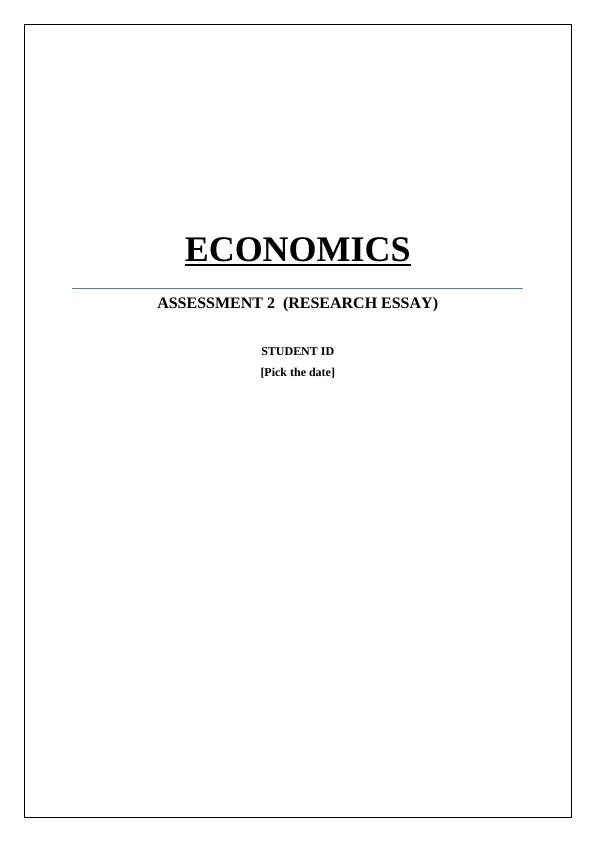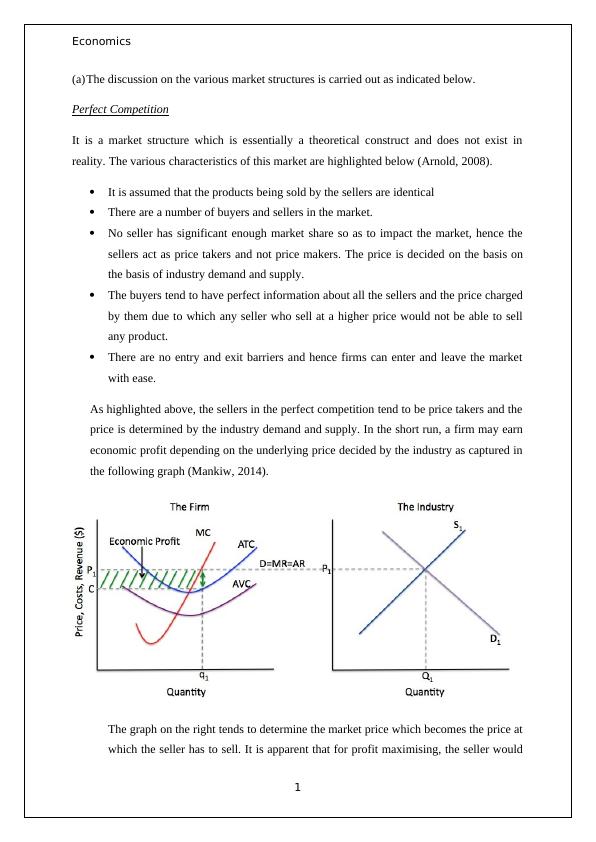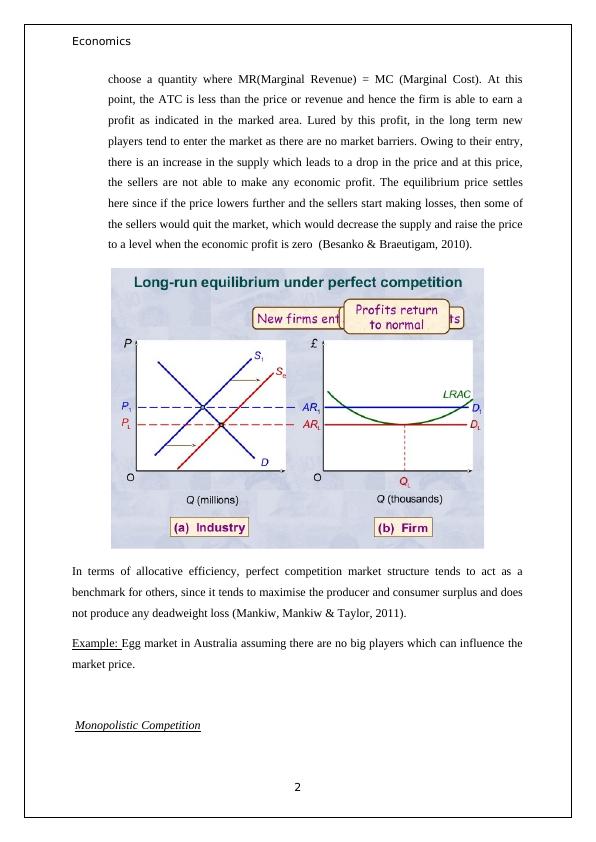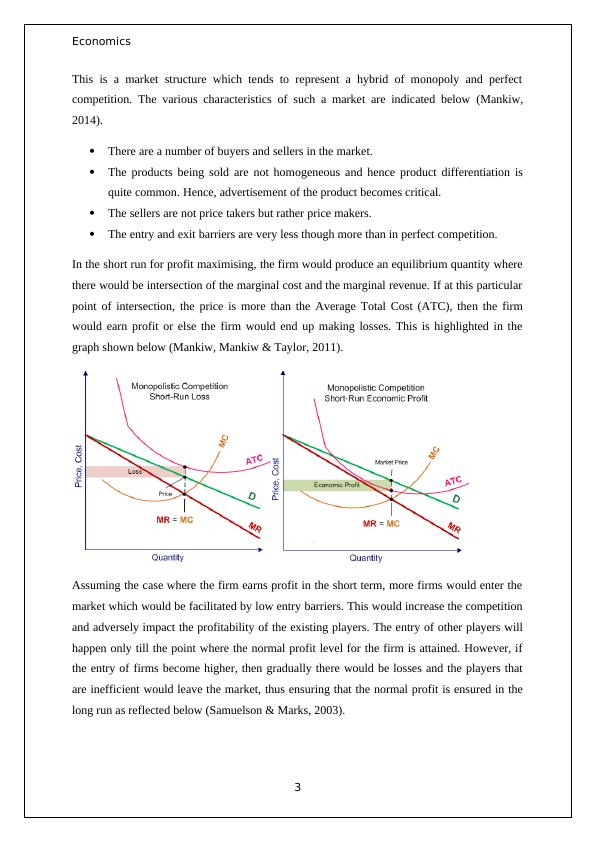The Perfect Competition Market
Added on 2020-02-24
11 Pages2522 Words389 Views
ECONOMICS
ASSESSMENT 2 (RESEARCH ESSAY)
STUDENT ID
[Pick the date]
ASSESSMENT 2 (RESEARCH ESSAY)
STUDENT ID
[Pick the date]

Economics
(a)The discussion on the various market structures is carried out as indicated below.
Perfect Competition
It is a market structure which is essentially a theoretical construct and does not exist in
reality. The various characteristics of this market are highlighted below (Arnold, 2008).
It is assumed that the products being sold by the sellers are identical
There are a number of buyers and sellers in the market.
No seller has significant enough market share so as to impact the market, hence the
sellers act as price takers and not price makers. The price is decided on the basis on
the basis of industry demand and supply.
The buyers tend to have perfect information about all the sellers and the price charged
by them due to which any seller who sell at a higher price would not be able to sell
any product.
There are no entry and exit barriers and hence firms can enter and leave the market
with ease.
As highlighted above, the sellers in the perfect competition tend to be price takers and the
price is determined by the industry demand and supply. In the short run, a firm may earn
economic profit depending on the underlying price decided by the industry as captured in
the following graph (Mankiw, 2014).
The graph on the right tends to determine the market price which becomes the price at
which the seller has to sell. It is apparent that for profit maximising, the seller would
1
(a)The discussion on the various market structures is carried out as indicated below.
Perfect Competition
It is a market structure which is essentially a theoretical construct and does not exist in
reality. The various characteristics of this market are highlighted below (Arnold, 2008).
It is assumed that the products being sold by the sellers are identical
There are a number of buyers and sellers in the market.
No seller has significant enough market share so as to impact the market, hence the
sellers act as price takers and not price makers. The price is decided on the basis on
the basis of industry demand and supply.
The buyers tend to have perfect information about all the sellers and the price charged
by them due to which any seller who sell at a higher price would not be able to sell
any product.
There are no entry and exit barriers and hence firms can enter and leave the market
with ease.
As highlighted above, the sellers in the perfect competition tend to be price takers and the
price is determined by the industry demand and supply. In the short run, a firm may earn
economic profit depending on the underlying price decided by the industry as captured in
the following graph (Mankiw, 2014).
The graph on the right tends to determine the market price which becomes the price at
which the seller has to sell. It is apparent that for profit maximising, the seller would
1

Economics
choose a quantity where MR(Marginal Revenue) = MC (Marginal Cost). At this
point, the ATC is less than the price or revenue and hence the firm is able to earn a
profit as indicated in the marked area. Lured by this profit, in the long term new
players tend to enter the market as there are no market barriers. Owing to their entry,
there is an increase in the supply which leads to a drop in the price and at this price,
the sellers are not able to make any economic profit. The equilibrium price settles
here since if the price lowers further and the sellers start making losses, then some of
the sellers would quit the market, which would decrease the supply and raise the price
to a level when the economic profit is zero (Besanko & Braeutigam, 2010).
In terms of allocative efficiency, perfect competition market structure tends to act as a
benchmark for others, since it tends to maximise the producer and consumer surplus and does
not produce any deadweight loss (Mankiw, Mankiw & Taylor, 2011).
Example: Egg market in Australia assuming there are no big players which can influence the
market price.
Monopolistic Competition
2
choose a quantity where MR(Marginal Revenue) = MC (Marginal Cost). At this
point, the ATC is less than the price or revenue and hence the firm is able to earn a
profit as indicated in the marked area. Lured by this profit, in the long term new
players tend to enter the market as there are no market barriers. Owing to their entry,
there is an increase in the supply which leads to a drop in the price and at this price,
the sellers are not able to make any economic profit. The equilibrium price settles
here since if the price lowers further and the sellers start making losses, then some of
the sellers would quit the market, which would decrease the supply and raise the price
to a level when the economic profit is zero (Besanko & Braeutigam, 2010).
In terms of allocative efficiency, perfect competition market structure tends to act as a
benchmark for others, since it tends to maximise the producer and consumer surplus and does
not produce any deadweight loss (Mankiw, Mankiw & Taylor, 2011).
Example: Egg market in Australia assuming there are no big players which can influence the
market price.
Monopolistic Competition
2

Economics
This is a market structure which tends to represent a hybrid of monopoly and perfect
competition. The various characteristics of such a market are indicated below (Mankiw,
2014).
There are a number of buyers and sellers in the market.
The products being sold are not homogeneous and hence product differentiation is
quite common. Hence, advertisement of the product becomes critical.
The sellers are not price takers but rather price makers.
The entry and exit barriers are very less though more than in perfect competition.
In the short run for profit maximising, the firm would produce an equilibrium quantity where
there would be intersection of the marginal cost and the marginal revenue. If at this particular
point of intersection, the price is more than the Average Total Cost (ATC), then the firm
would earn profit or else the firm would end up making losses. This is highlighted in the
graph shown below (Mankiw, Mankiw & Taylor, 2011).
Assuming the case where the firm earns profit in the short term, more firms would enter the
market which would be facilitated by low entry barriers. This would increase the competition
and adversely impact the profitability of the existing players. The entry of other players will
happen only till the point where the normal profit level for the firm is attained. However, if
the entry of firms become higher, then gradually there would be losses and the players that
are inefficient would leave the market, thus ensuring that the normal profit is ensured in the
long run as reflected below (Samuelson & Marks, 2003).
3
This is a market structure which tends to represent a hybrid of monopoly and perfect
competition. The various characteristics of such a market are indicated below (Mankiw,
2014).
There are a number of buyers and sellers in the market.
The products being sold are not homogeneous and hence product differentiation is
quite common. Hence, advertisement of the product becomes critical.
The sellers are not price takers but rather price makers.
The entry and exit barriers are very less though more than in perfect competition.
In the short run for profit maximising, the firm would produce an equilibrium quantity where
there would be intersection of the marginal cost and the marginal revenue. If at this particular
point of intersection, the price is more than the Average Total Cost (ATC), then the firm
would earn profit or else the firm would end up making losses. This is highlighted in the
graph shown below (Mankiw, Mankiw & Taylor, 2011).
Assuming the case where the firm earns profit in the short term, more firms would enter the
market which would be facilitated by low entry barriers. This would increase the competition
and adversely impact the profitability of the existing players. The entry of other players will
happen only till the point where the normal profit level for the firm is attained. However, if
the entry of firms become higher, then gradually there would be losses and the players that
are inefficient would leave the market, thus ensuring that the normal profit is ensured in the
long run as reflected below (Samuelson & Marks, 2003).
3

End of preview
Want to access all the pages? Upload your documents or become a member.
Related Documents
Assignment on Managerial Economics Doclg...
|2
|467
|98
Pear Market: A Perfectly Competitive Marketlg...
|7
|1598
|322
Principles of Economics: Perfect Competition, Monopoly, Price Discrimination and Externalitieslg...
|12
|2326
|279
BB106 - Economic Principles - Report On Tomato Marketlg...
|7
|1345
|40
Monopoly & Monopolistic Competition in Australialg...
|10
|2512
|473
Economics Assignment - Competitive Marketslg...
|2
|379
|362